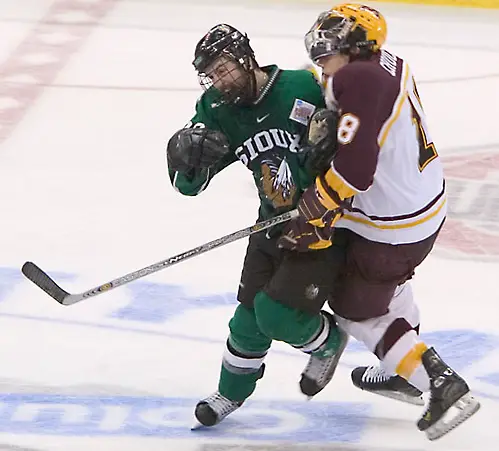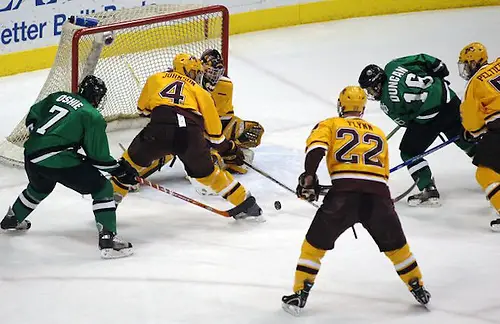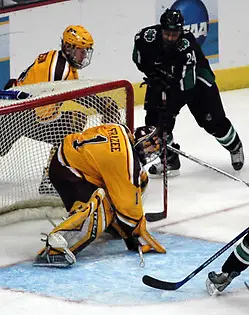
It seems only fitting that one year after they left the WCHA for different conferences, two of the teams involved in one of that league’s fiercest rivalries will meet again on college hockey’s biggest stage.
Dating to 1951 and the first time Minnesota and North Dakota played in the same conference, the two teams often were near the top of the standings and combined to win 12 national championships — five for the Golden Gophers and seven for the then-Fighting Sioux (North Dakota’s moniker before the 2011-12 season).
[scg_html_ff2014]When they play in the national semifinals on Thursday in Philadelphia, it will be the 291st meeting between the teams and the fifth in the NCAA tournament.
“I think these are two very respectable programs and that’s why they’ve had success,” said Wally Shaver, the longtime Minnesota radio voice. “They’ve had great administrations and great coaches running these two programs, and that consequently resulted in a rivalry that has always been there.”
That combined success, the schools’ geographic location and a conference schedule that often provided four-plus meetings each season boiled the pot on one of college hockey’s legendary rivalries.
“When the two teams were playing, they weren’t playing for the bottom spot in the league,” said Tim Hennessy, the longtime radio voice for North Dakota. “Whenever Minnesota and North Dakota played it generally was in important games.”
The teams first played on Feb. 4, 1930, 22 seasons before they became members of the Midwest Collegiate Hockey League, which later was known as the Western Intercollegiate Hockey League before its teams reformed as the WCHA.
But the origins of Minnesota and North Dakota’s bad blood stems back to the 1960s and 1970s. At that time, Minnesota frequently had an all-American roster while North Dakota often looked to the hotbed of western Canada for talent.
Dean Blais has a unique perspective on the clash, having played and been an assistant coach at Minnesota before later becoming coach of North Dakota from 1994 to 2004.
“Over the years the rivalry has changed because of the recruiting,” said Blais, who is now the coach at Nebraska-Omaha. “Back a while ago it was a lot of Canadians at North Dakota and Minnesota was all Americans, so there was a little bit of the American-Canadian rivalry mixed in.”
North Dakota sustained more success in the 1960s, but under coach Herb Brooks, Minnesota took flight in the 1970s. That era would culminate in the 1979 NCAA title game as Brooks’ Gophers met the Fighting Sioux under first-year head coach John “Gino” Gasparini at Olympia Stadium in Detroit.
“That season’s rivalry really got started in a game at Minot, N.D., when they had the line brawl,” Hennessy said. “I’ll never forget after the game Herb coming up and saying tell that Italian [whatever you want to call it] person that if he’s going to pull that stuff in this league, he’s got another thing coming.”
That titanic title contest was decided on one of college hockey’s most historic goals.
“You can still see it on YouTube with [Gophers forward Neal] Broten diving and chipping the puck over the sliding North Dakota goaltender,” Hennessy said. “It was a hotly contested game and afterwards Minnesota rolled out a big banner that said ‘The All-American team.’ That really put some salt in the wound and energized both sides.”
North Dakota claimed the title a year later as Gasparini’s Fighting Sioux enjoyed success throughout the 1980s, also claiming NCAA titles in 1982 and 1987.
Minnesota impressed in the late 1980s and early 1990s with coach Doug Woog at the helm, while North Dakota slid back.
Enter former Golden Gophers player Blais to re-stoke the fires of rivalry.
Under Blais’ watch the Sioux appeared in the national title game three times in five years, winning a pair of titles (1997 and 2000), and beginning a stretch of 16 NCAA tournament appearances in 17 years.
“In 1997 we played Minnesota in the WCHA Final Five [championship game],” Blais said. “Peter Armbrust, from Edina, Minn., scored the overtime winning goal to propel us to a No. 1 seed in the NCAA tournament.”
During his tenure, Blais’ teams utilized many talents like Armbrust from the Gopher State. Two of their most prominent Minnesota products were goaltender Karl Goehring of Apple Valley (1997-2001) and Zach Parise of Minneapolis (2002-04).
Current St. Cloud State coach Bob Motzko, who was an assistant coach at Minnesota from 2001 to 2005, remembers his team opening the new Ralph Engelstad Arena in a nonconference clash between the two schools in 2011 and the personal battles between Parise and Gophers forward Thomas Vanek.

“The [New Ralph] opener turned out to be a crazy hockey game with [Jordan] Leopold scoring from almost the other end of the rink,” Motzko said of Gophers’ 7-5 win. “Then [a year later] you had the Vanek and Parise battle, with Vanek winning the league’s rookie of the year.”
Minnesota returned to prominence under coach Don Lucia, winning back-to-back national championships in 2002 and 2003. One of Lucia’s first recruiting coups was nabbing Grand Forks native Grant Potulny (2000-04), who is now an assistant coach on Lucia’s staff.
En route to Lucia’s first title, the Golden Gophers ended UND’s season with a memorable first-round WCHA series sweep.
“We won the first game 7-2 and then Game 2 was really tight,” Motzko said. “In overtime, our defenseman Keith Ballard was tangled up in our zone with one of their guys. As he was going down with him, he threw [the Sioux] player’s jersey over his head. [Keith] then gets up and skates down to the other end of the ice where he tapped in the winning goal.”
In the historic 2004-05 season when four WCHA teams reached the Frozen Four, North Dakota knocked off Minnesota 4-2 in the national semifinals before losing to Denver in the title game. Two years later, the Gophers won a WCHA tournament title with a 3-2 overtime win over the Fighting Sioux.
“The game that comes to mind immediately for me was when Blake Wheeler got that diving overtime goal with a backhanded swat of a puck out of the air,” Shaver said. “It was a dramatic and really intense game topped off by one of the more unique hockey plays I’ve ever seen.”

However, the Fighting Sioux got the better of the Golden Gophers by the same score in the NCAA tournament before losing 6-4 in the national semifinals to Boston College.
“The 2005 NCAA game between the two teams was pretty nondescript, but I can still see Chris Porter scoring on a wraparound goal to beat Minnesota in overtime in the 2007 NCAA tournament,” Hennessy said. “I don’t think anybody will ever forget that one.”
Most recently, Minnesota ousted North Dakota in the 2012 NCAA tournament 5-2 before losing to the eventual champion Eagles 6-1 in the national semifinals. It was a revenge win for the Golden Gophers, who were crushed by North Dakota 6-3 in the WCHA semifinals one week earlier.
With Penn State starting a hockey program, the long awaited formation of the Big Ten hockey conference finally came to fruition. One of the unintended consequences was the breakup of some of college hockey’s great rivalries like Minnesota-North Dakota.
“We’ve kind of always known that if a sixth Big Ten school added college hockey, there was going to be a new conference,” Shaver said. “But I don’t think the intensity or interest level with a Minnesota-North Dakota game going forward will ever change. There is way too much out there with social media and other things to fuel the fire and, believe me, these players are well aware of it.”
There will be plenty of interest in this game, but like Detroit-Chicago or Detroit-Colorado in the NHL, the new landscape could result in some water being thrown on the fires of the rivalry, especially for the fans.
“As the years go by I think Minnesota-North Dakota probably will diminish,” Hennessy said. “I don’t think North Dakota will have any problem finding new rivals, but in the future even if the two teams meet in nonconference play like they will in two years, it just won’t be the same.”
Yet, this week in Philadelphia, the rivalry fires will be renewed once again, regardless of conference affiliation. With the stakes involved (neither team has won a NCAA title since 2003), this latest chapter has the potential to be among the best games, even if it’s not quite as personal as it used to be.
“Obviously the excitement of the North Dakota-Minnesota rivalry is there right from square one,” UND coach Dave Hakstol said. “Nobody is hiding from that, everybody embraces that and is excited for that, but I haven’t seen a whole lot different in the demeanor of my team.”
Some players came to each school itching for a crack at playing the other. Others remember some of the team’s most recent battles. Now it is up to the coaches to make sure their teams are prepared to handle the big stage and keep their composure.
“I don’t have to throw on a tape to know how North Dakota plays because over the years we’ve played them enough,” Lucia said. “It’s a great matchup and it’s good for college hockey that we are playing on this stage. I think the fans will light up the message boards a little bit and will enjoy that part of it. We’re looking forward to playing a very good, well-coached team and it should be a really good game.”


